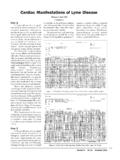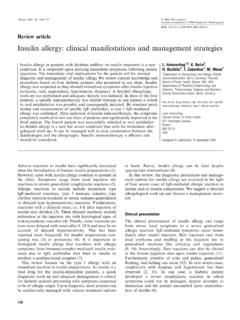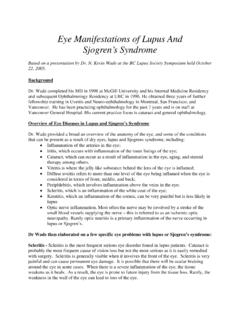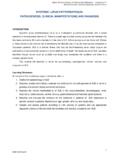Transcription of Extrahepatic manifestations in HCV infection Extrahepatic ...
1 Extrahepatic manifestations in HCV infectionJ Gastrointestin Liver DisMarch 2007 No 1, 65-73 Address for correspondence:Prof. Claudio PuotiDept. of Internal MedicineMarino General HospitalVia XXIV Maggio00045 Marino, Rome, ItalyE-mail: manifestations of Chronic HCV InfectionAlessandra Galossi1, Riccardo Guarisco1, Lia Bellis 2, Claudio Puoti11) Department of Internal Medicine. 2) Digestive Diseases, Haemodynamic Unit, Marino General Hospital,Marino, Rome, ItalyAbstractSeveral Extrahepatic manifestations have been reportedin the natural history of hepatitis C virus infection (HCV).Up to 40-74% of patients infected with HCV might developat least one Extrahepatic manifestation during the course oftheir disease.
2 Mixed Cryoglobulinemia (MC) is the mostknown and studied syndrome associated with HCV is a systemic vasculitis that may involve the skin, kidneyand nervous system. A frequent reported association isthat between HCV infection and non-Hodgkin cryoglobulinemia may be the intermediary disorder, infact some persistent forms of cyoglobulinemia can switchover to a more aggressive haematologic disorder. Ascompared to cutaneous vasculitis described in MC, HCVinfection has been associated with dermatological disorderssuch as porphyria cutanea tarda and lichen planus. Thyroiddisease (usually hypothyroidism) is commonly seen inpeople with HCV. Up to 25% have thyroid antibodies. Severalstudies described a correlation between HCV and lympho-cytic sialoadenitis, similar to sialoadenitis associated withidiopathic Sj gren syndrome, but we can define as pseudo-Sj gren syndrome the one associated with HCV infection ,because it shows several differences in the idiopathic the course of chronic HCV infection , a common obser-vation are rheumatological symptoms such as clinical pattern of joint involvement in the course ofHCV infection varies from a rheumatoid arthritis-like form(very rare)
3 , to a non erosive oligoarthritis involving the large-sized and middle wordsExtrahepatic manifestations - chronic HCV infection -mixed cryoglobulinemia - B-cell - non-Hodgkin lymphoma -pseudo-Sj gren syndromeIntroductionSeveral Extrahepatic manifestations (EHM) have beenreported in the natural history of Hepatitis C Virus (HCV) infection (1). According to different studies, 40-74% ofpatients infected with HCV might develop at least one EHMduring the course of the disease (2,3). Further, EHMsyndromes could represent the first signal of an HCVinfection, as many patients show no hepatic et al (4) first described an association betweenHCV and EHM in 1990, reporting two patients with mixedcryoglobulinemia.
4 Subsequenttly, the involvement of allorgans and systems was reported (kidney, skin, thyroid,eyes, joints, nervous system). In 1999 Zignego et al (5)classified EHM of HCV infection in four groups (Table I).Table I Classification of Extrahepatic manisfestations in HCVinfectionGroup Aassociation defined on the basis of strongprevalence and clear pathogenetic mechanismGroup Bprevalence higher than controlsGroup Csyndromes to be confirmed or characterizedGroup Danecdotal observationsPathogenesisThe infected Extrahepatic tissues might act as a reservoirfor HCV (6) and play a role in both HCV persistence andreactivation of infection . HCV as an etiological agentreplicating and expressing viral proteins in extrahepatictissues itself contributes to EHM associated with chronicHCV important feature of HCV is that the virus avoidsimmune elimination.
5 A consequence is chronic infection , anaccumulation of circulating immunocomplexes and auto-immune phenomena (7). HCV shows a particular lympho-tropism other than hepatic tropism, that is responsible formany cryoglobulinemia (MC)Mixed cryoglobulinemia (MC) is the most known andstudied syndrome associated with HCV infection (8,9).Galossi et al66 Cryoglobulins are immunoglobulins that reversiblyprecipitate at a temperature lower than 37 . Cryoglobulinshave been classified by Brout et al (10) on the basis of theimmunoglobulin clonality (Table II). HCV is stronglyassociated with MC type II and III (11). Cryoprecipitatesusually contain large amounts of HCV antigen and/orantibodies against HCV (8).Table II Classification of cryoglobulinsTypeType IType II(mixed)Type III(mixed)Clonality of immunoglobulinsMonoclonal immunoglobulins (IgGor IgM)Polyclonal immunoglobulins(mainly IgG) plus monoclonalimmunoglobulins (IgM, IgG, IgA)Polyclonal IgG and polyclonal IgMAssociated diseasesLymphoproliferativediseasesMixed cryoglobulinemiaMixedcryoglobulinemiaMix ed cryoglobulinemia is a systemic vasculitischaracterized by the deposition of circulating immuno-complexes in small and medium-sized blood vessels resultingin clinical manifestations .
6 Cryoglobulins can be found inpatients with HCV infection in 19% up to 50% according todifferent studies (12-13). The prevalence of MC increaseswith the duration of the disease. Some studies of patientswith chronic HCV and MC showed that the duration of thedisease was almost twice as long than in patients withoutMC (12). Cryoglobulins are usually found at lowconcentrations and 90% of patients have few or no clinicalmanifestations (14). Only a small fraction of patients withMC associated with HCV (less than 15%) have lymphoproliferation represents the pathologicaltrigger (7). Indeed, it has now become clear that HCV showsa high tropism for peripheral lymphocytes, which may serveas its reservoir and a place for it to replicate (6).
7 Flint et aldescribed that the virus C binds to tetraspanin CD81 ligandon the surface of B- lymphocytes via E2 protein (the secondportion of the HCV envelope) leading to activation of theselymphocytes (15). Initially, only polyclonal crioglobulins areproduced, then a dominant B-cell clone emerges, producingmonoclonal of HCV RNA and anti-HCV antibodiesare much higher in the cryoprecipitate than in the serum(16). Some studies reported an association between MC andHCV genotype 2a, but this should be confirmed (17).with mononuclear infiltration. HCV antigens are detected inskin lesions in 40% of cases (18).Kidney is frequently involved (35-60%) in the course ofMC related to chronic HCV infection (19). The prevalenttype of glomerulonephritis associated with MC is amembranous proliferative glomerulonephritis (MPGN) (20).
8 Anti-HCV antibodies are universal in patients with bothcryoglobulinemia and MPGN. HCV-RNA is present in nearly81% of MC related MPGN versus only 25% of cases ofnoncryoglobulinemic MPGN (8). In 25% of cases patientsdevelop proteinuria in nephrotic range (> 3 g/24 h), oedema,hypertension and hypocomplementemia. In 30% of casesrenal involvement begins with a nephritis syndrome andacute renal failure (oliguric in 5% of cases). In 55% of casespatients present only mild hematuria, mild proteinuria andmild renal insufficiency. Renal involvement can be presentat the onset of the disease in about 20% of patients (19).The presence of kidney impairment is a negative prognosticfactor in the course of disease (21).
9 Renal biopsydemonstrates immunocomplexes deposits of IgG, IgM withrheumatoid factor (RF) activity and C3 in capillary most characteristic histological findings are thecapillary thrombi consisting of precipitated cryoglobulinsat light microscopy. Less often HCV causes focal segmentalglomerular sclerosis or membranous or proliferativeglomerulonephritis (22).The course of renal pathology is variable. A clinicalregression is observed in 10-15% of patients with nephriticsyndrome. In 30% of cases, the clinical trend is slow andrenal function is maintained for many years. In 20% ofpatients the disease is characterized by recurrent episodesof nephritic syndrome. In less than 15% of MC patientsdialysis is required for terminal 7 up to 90% of cases of MC there is a peripheralneuropathy, that represents one of the most seriouscomplications of organ involvement in MC (23-24).
10 MCrelated neuropathy is mostly sensory and is characterizedby numbness, burning, needles and pins sensations, skincrawling and itching that occurs most often in the handsand feet, but can appear in other areas of the a mononeuritis multiplex is present. Biopsy showsaxonal damage with epineural vasculitic infiltration andendoneural microangiopathy. Therapy with interferon alphacan worsen a MC related polyneuropathy (25).Neurological involvement has been described also inpatients with HCV infection without MC (26). Particularlythere is neuropathy associated with polyarteritis nodosa inthe course of HCV infection , that typically is an asymmetricalpolyneuropathy with prominent motor authors have analyzed the association betweenMC and liver damage.








